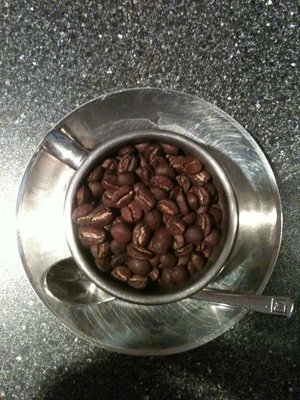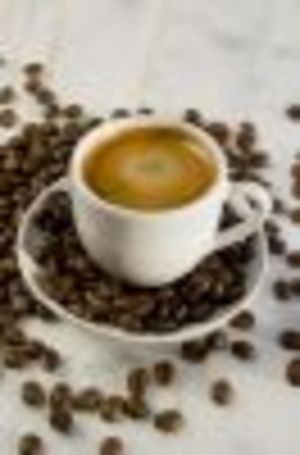Do popular coffee houses sell the same quality of beans in the grocery store compared to what is used by the barista in your favorite coffee house? America’s Test Kitchen, one of my favorite PBS (Public Broadcasting Service) cooking shows has come out with the results from this year’s coffee taste test showdown. The Test Kitchen devoted hours of experiments, taste-testing eight different top-named brand coffees so that we as consumers can purchase top-quality coffee house beans in grocery stores to make at home for half the price.
Why not just purchase from the popular coffee houses? Let’s face it, gasoline prices are sky-rocketing which in conjunction coffee brewers are constrained to also boost prices. Consumers have been warned by many of the finest financial advisors such as Robert Kiyosaki and David Bach about the effects of the “latte factor. The “Latte Factor” is a simple strategy that informs people to not get in the habit of overspending on foolish items, when the same item can be created at home for half the price. For instance, a person might spend $4.00 on a Starbucks cup of coffee twice a day which ends up being $40.00 a week. If this same person purchased a bag of Starbucks coffee beans from the store and brewed the concoction each morning before leaving the house, a total savings of around $30.00 would be done that week just on coffee alone. Therefore it just makes sense that consumers save their money on coffee to subdue steep gasoline bills.
So, which coffees were tested? America’s Test Kitchen listened to consumers and took the advice to include some of the most popular name-brand coffees in America. These coffee brands were Starbucks, Green Mountain Roasters, Seattle’s Best Coffee, Millstone, Eight O’clock, Dunkin’ Donuts, Chock Full o’ Nuts and Folgers.
How was the testing done? 1. Many hours were taken in the Test Kitchen in the process of taste-testing with 25 average everyday coffee drinkers, not professional coffee taste-testers. This was done in two steps, one test was done with plain black coffee and the other test was done with 3/4 cup warmed whole milk added to each black cup of coffee. 2. Then, after the results were in, an Agtron was used to test the strength of the bean to determine the length of roasting that was done on each coffee bean. The agtron results confide to consumers the amount of light that each name-brand coffee bean reflects. The lower the amount of light reflected the lower the roasting process that the bean had endured, which basically means the lower the roasting process the weaker the coffee taste. 3. Thirdly, the coffee brands were taken to a special data testing company that gave quaker amounts per coffee bag. A quaker is a coffee jargon term that refers to a coffee bean that is left in the pre-packaged coffee bag that has not completely finished roasting. Just one quaker can leave a normal cup of java tasting a little pungent.
What were the results of the plain black cup of java? The results were found to be astonishing to me, Starbucks coffee was found not on the top of the list as a previously would have thought before going into the taste-testing experiment. Green Mountain Roasters and Eight O’Clock coffee brands were the taste-test winners of this experiment.
What were the results of the plain black cup of java with milk? Although I usually drink my coffee plain with no sugar and milk, I do on the slight occasion pour a little milk in the cup for a lighter coffee flavor. The taste-test results were quite astonishing; I learned I should purchase two different types of coffee brands for the occasional milk and coffee mixture days. The winners of this category were Starbucks, Millstone and Seattle’s Best coffee.
What were the results from the agtron reading? America’s Test Kitchen found these results for the agtron readings: the lower the number the darker the roast/the higher the number the lighter the roast. The Test Kitchen found: “Starbucks (34.9), Millstone (36.5), Seattle’s Best (40.0), Chock Full o’ Nuts (40.3), Green Mountain (48.0), Folgers (48.9), Eight O’Clock (51.4), and Dunkin’ Donuts (59.9).”
What were the results of quaker amounts? Remember that a quaker is an unroasted coffee bean and can change the taste of the coffee when brewed. Three coffee bags were found to have quakers Chock Full o’ Nuts had seven, Folgers had eight and Dunkin’ Donuts was found to have the highest with a count of nine. These tests were per one cup; therefore, in one bag of Dunkin’ Donuts a consumer might get around 40 quakers. In other brands such as Starbucks, one might find a few however it is very uncommon.
If you are wondering about your own coffee at home, take the entire bag out and pour it into a bowl. Look through the beans and any beans that are lighter in color than the other beans is a quaker. If this quaker is taken out, your brewed coffee will taste better. If you want to go farther, take these un-roasted beans and place them in the coffee pot and brew just the quakers. A rancid smell will come out that is discolored and not a pretty sight. Be careful though (as I learned the hard way) this test makes your house smell really bad for a few hours.
Choosing the right name-brand coffee is up to your personal preference however the results show that it is possible to get the same quality of coffee at a grocery store compared to the coffee from the barista. If your preferences are for a darker roast without milk, the results show your best option will be Green Mountain. If you drink your coffee with milk though, try Millstone or Seattle’s Best coffee. Lighter roast drinkers should try Eight O’clock coffee. Remember to stay away from the quaker full coffee blends. If you do choose these blends as your favorite, remember to pick out the lighter colored beans and throw them away.


